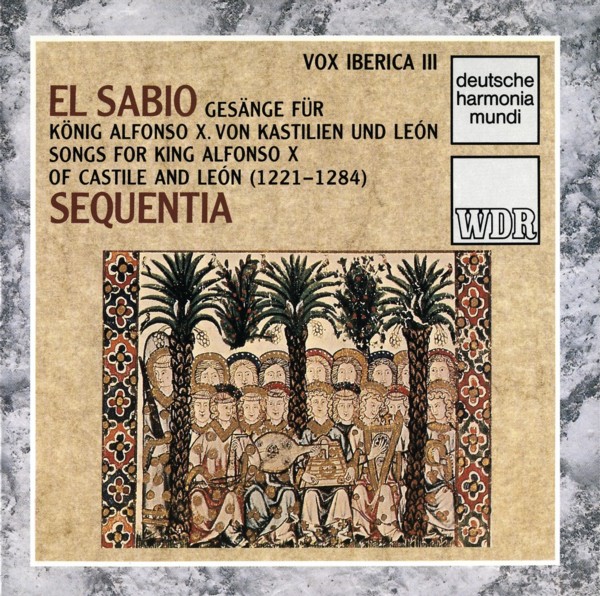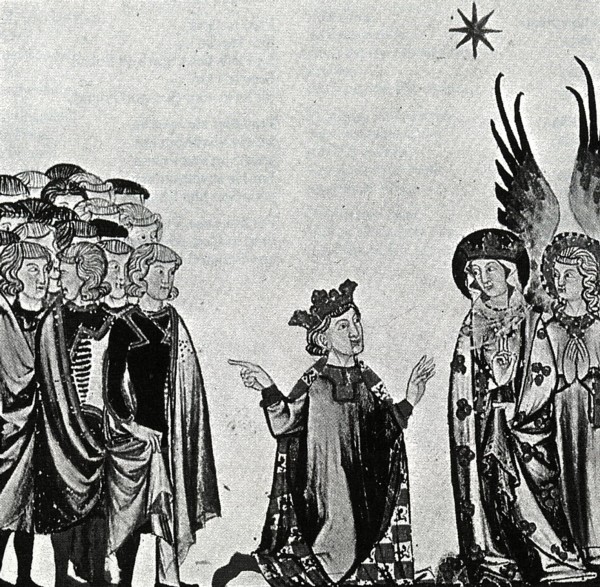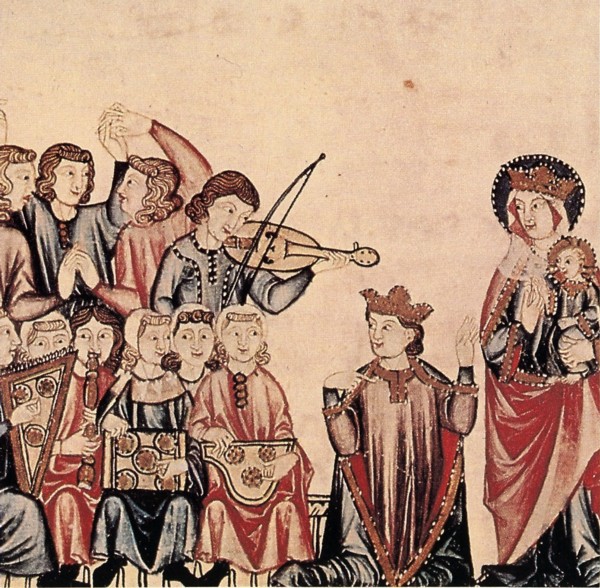
medieval.org
Deutsche Harmonia Mundi BMG 77173
1991

medieval.org
Deutsche Harmonia Mundi BMG 77173
1991
1. Por nos, Virgen Madre [2:12]
CSM 250
women
2. Como o nome da Virgen [5:14]
CSM 194
B. Bagby, rabab, men
3. Sobelos fondos do mar [8:28]
CSM 193
women
4. Nenbre-sse-te, Madre de Deus, Maria [2:39]
CSM 421
men
5. Dized', ai trobadores [1:06]
CSM 260
B. Bagby, B. Schneider, E. Mentzel, men
6. Maldito seja quen non loará [3:41]
CSM 290
men, fiddle, symphonia
7. Quantos me creveren loarán [3:08]
CSM 120
E. Mentzel, R. Nolte, men
8. Quen bõa dona querrá [6:07]
CSM 160
S. Norin, women, organistrum, tutti
9. Pero que seja a gente [6:52]
CSM 181
men, fiddle, lute, tutti
10. Guiraut RIQUIER. Humilis, forfaitz, repres e penedens [8:10]
B. Thornton
11. Santa Maria, strelo do dia [3:11]
CSM 100
tutti, fiddle
12. Pois que Deus quis da Virgen fillo [9:04]
CSM 38
B. Thornton, S. Norin, women, harp
13. Macar poucos cantares acabei e con son [6:13]
CSM 401
B. Bagby
KHARJAS
14. Que faray mamma? [1:20]
S. Norin, women
15. Meu sidi Ibrahim [2:32]
S. Norin, women, rabab, lute
16. Gar si yes devina [1:11]
B. Thornton
17. Garid vos ay yermanellas [2:17]
S. Norin, B. Thornton, women, rabab, lute
( cf. CSM 353 )
18. En todo logar á poder [4:11]
CSM 168
tutti, fiddle, lute
|
SEQUENTIA,
Ensemble für Musik des Mittelalters Barbara Thornton, Benjamin Bagby | |
|
women's ensemble Barbara Thornton Elizabeth Glen Debra Gomez Cornelia Melián Susanne Norin Consuelo Sañudo instruments Rainer Ullreich, fiddle, rabab Benjamin Bagby, harp, lute Eric Mentzel, symphonia, organistrum |
men's ensemble Benjamin Bagby Stephen Grant Eric Metnzel Raimund Nolte Bernhard Schneider |

· Fiddle by Richard Earle (Basel, 1988)
· Rabab by Rainer Ullreich (Vienna, 1990)
· Lute (after Alfonso el Sabio's Libro de ajedrez, dados y tablas) by Richard Earle (Basel, 1989)
· Harp by Rainer Thurau (Wiesbaden, 1985)
· Symphonia by Bernhard Ellis (Herefordshire, GB, 1978)
· Organistrum (based on sculpture of the Pórtico de la Gloria in Santiago de Compostela) by Alan Crumpler, Leominster, GB, 1982
SOURCES
Cantigas de Santa Maria
The musicians performed from facsimiles of the original manuscripts
(El Escorial, Real Monasterio de El Escorial, B.1.2. [E1] and T.I.1. [E2];
and Madrid, Biblioteca Nacional, Ms. 10069 [To])
in conjunction with the text edition of Walter Mettmann: Alfonso X: Cantigas de Santa Maria, Coimbra, 1959-72 (4 vols.).
In certain cases, the standard edition of Higini Anglès
(La música de las Cantigas de Santa María del Rey Alfonso el Sabio,
Barcelona, 1943-59), which includes a full facsimile of the principle
musical source (E1), was also consulted.
Assistance in the pronunciation
of the Gallician-Portuguese texts provided by Consuelo Sañudo.
Humils, forfaiftz, repres e penedens
The
unique musical manuscript source (Paris, Bibl. Nat. fr. 22543,
fol.105v) was used in conjunction with the text edition of Martin
Riquer, Los Trovadores (3 vols.), Barcelona, 1975, p.1618.
"Kharjas"
The text edition of Samuel M. Stern (Les Chansons mozarabes,
[reprint: Oxford, 1964]) was used together with melodies reconstructed
by Benjamin Bagby, based on melodic material from the Cantigas de Santa
Maria and the Andalusian Naubatu r-rasid, mīzānu l-quddami.
℗ © 1992 harmonia mundi, D-7800 Freiburg
Producer: Klaus L Neumann
Recording: Barbara Valentin (WDR)
Editing: Dietrich Wohlfromm
Technical equipment: WDR Köln
Recorded: 11.-14. 2. 1991 Seewen, St Germanus (CH)
Cover art: miniatures from: Las Cantigas de Santa Maria El Escorial, Ms. T.I.1, fol. 145 & 170.
Redaktion: Dr. Jens Markowsky
All rights reserved
HARMONIA MUNDI D-7800 FREIBURG
Eine Coproduktion mit dem Westdeutscher Rundfunk Köln
deutsche harmonia mundi

El Sabio
Songs for King Alfonso X (the Learned) of Castile-León (1221—1284)
By the time the 31-year-old don Alfonso
inherited the crowns of Castile and León in 1252, ascending to his
title, Alfonso X, he had long since begun to earn the laudatory name
which would follow him into posterity: El Sabio, the Learned, the
enlightened monarch hungry for wisdom, whose innumerable scholarly
projects would help raise his realm (and the Castilian language) into
the European mainstream; his illustrious court became a center of
knowledge, research and art.
Alfonso used his enormous personal
energy and resources to realize a wide-ranging program of legal,
scientific, historical, religious, literary and musical endeavors.
Although he certainly made significant personal contributions (and is
customarily named as author) to the many works produced during his
reign, he was in fact more of a motivator, a patron and editor,
assembling and directing teams of experts from the three religions of
his realm: Christianity, Islam, and Judaism.
As a youth, the
studious prince Alfonso found himself at the side of his crusader
father, San Fernando III, during the sieges of Moslem Seville and other
Islamic states. But later, this polymath visionary was to become
anything but a successful ruler and politician. For decades the
philosopher-king intrigued in vain to become Holy Roman Emperor (a claim
he could make through his German mother, Beatrice of Swabia), draining
the kingdom of its resources, pressuring and alienating his nobles and
destabilizing the political balance of the Iberian peninsula. In the end
even his own son turned against El Sabio in armed rebellion, and
Alfonso died in his beloved city of Seville, bitter and abandoned. The
substance of Alfonso's regency was summarized by the Jesuit historian
Juan de Mariana, writing in 1601: 'While he was pondering the heavens
and looking at the stars he lost the earth and his kingdom".
The Cantigas de Santa Maria
The process of gathering, editing, copying and illustrating the Cantigas de Santa Maria
[CSM] (= Canticles of Holy Mary) was one of the learned king's most
successful projects: it entailed a vast collection of Marian
miracle-stories (cantigas de miragre) grouped in sets of ten (with every tenth cantiga a song in praise of the miraculous Virgin, a cantiga de loor),
written in courtly Galician-Portuguese verses set to melodies from a
multitude of sources, and accompanied by miniatures depicting a great
variety of contemporary situations. Our recording features a
cross-section from this unique collection (a complete recording would
fill at least 25 CDs!), and attempts to recreate several modes of
"performance" as they would have been known at Alfonso's court: the
intensely personal utterances of the king himself (13), perhaps intended
for an audience of only a few chosen courtiers; the singing of cantigas de loor
(1, 4, 7, 8, 11) by and for the faithful in the cathedral of Seville on
Marian feast-days; the participatory singing and playing of Marian
miracle-stories (cantigas de miragre) at courtly gatherings,
during which professional minstrels were joined by noble amateurs for an
evening of devotional entertainment (2, 3, 5, 6, 9, 12).
Today
it is difficult, given the imposing nature of a single repertoire
numbering over 400 compositions, to bear in mind that the musical life
of Alfonso's court was diverse, sophisticated and cosmopolitan, enjoying
the last fruits of the courtly trobador tradition of the langue d'oc
as well as the new ideas and sounds of clerical musicians in contact
with the French cultural mainstream. The elevated status of such
musicians and poets guaranteed them written documentation (although not
as lavish as the CSM) allowing us to hear their voices through
notation. However, other types of music known to Alfonso had their
origins in ancient oral traditions which never or rarely were fixed in
ink and parchment: the instrumental virtuosity of professional minstrels
(visually catalogued by the king's artists in thrilling miniatures in
one of the CSM manuscripts), the amorous or humorous cantigas de profanas
ascribed to Alfonso (only the texts survive), courtly and popular songs
in Castilian, Galician, and Mozarabic dialect (performed by Mudejar
and Jewish entertainers), and story-telling singers (like the
Catalonian jograr in our Nr. 2) from all over the Iberian peninsula. It
is likely that Alfonso himself, during his childhood in Galicia, first
heard a Marian miracle-story sung by such an itinerant bard visiting the
court where he was raised.
Humils, forfaitz, repres e penedens (Nr. 10)
Guiraut
Riquier (b. Narbonne ca. 1230, d. ca. 1300), is widely known as "the
last of the trobadors". This master of many genres came to Alfonso's
court in ca. 1270, where he remained until 1279. Particularly revealing
of artistic life at court is his supplicatio to the king, written in 1274, in which he asks his patron to separate the elevated inventores from mere ioculatores,
thereby guaranteeing the status of the practitioners of high art (one
can imagine what intrigues might have caused Guiraut, surrounded by
ambitious young courtiers and popular love-poets, to turn to El Sabio for recognition and protection). In reply, the king wrote a poetic declaratio (perhaps actually written for him by Guiraut) in the language of the trobadors, in which Guiraut was declared to be don doctor de trobar, receiving special status at court.
Of Guiraut's 89 surviving poems (48 with melodies) we hear Humils, forfaitz, repres e penedens,
written in 1273 at Alfonso's court. This heartfelt, personal prayer
addressed to the Virgin Mary shows that Guiraut was one of the first
poets to develop a Maria-character designed to intervene directly into
personal spiritual life (a favorite mode of devotion for late medieval
poets). This poem contains virtuosic elements, among them the sustaining
of a uniform rhyme scheme over all five strophes and two tornadas,
a noble, weighty line structure of 10-syllables per line, and the
highly personal appeal despite the superimposition of a strict
formality. The poet-singer gives us an intricate melody written in a
direct and open D-mode, yet his attention is nonetheless constantly
fixed upon one overriding emotion: feeling low, humbled. Beyond these
great merits, the beauty of the poem comes from the truth of its
imagery: what more touching and authentic depiction exists of the
trepidations of the one who walks the spiritual path than the fifth
strophe of this canso?
Kharjas (Nr. 14)
Finally, our homage to El Sabio includes a group of kharjas: tantalizing little erotic texts, sung by young women (very much in the tradition of the cantigas de amigo), which Moslem and Hebrew poets of Andalusia incorporated as final verses into their more formal and courtly strophic muwashshahs.
One of the last exponents of this art, a Jew named Todros Halewi
Abulafia (d. 1295), was an important courtier to King Alfonso. These
miniature texts in the colloquial Romance dialect of the Mozarabs (the
oldest extant texts in Spanish, written using Arabic characters and not
deciphered until 1948) bear witness to one of the earliest European
vernacular vocal traditions: women's songs of sensuality and desire. In
our reconstruction we glimpse the last remains of a courtly oral
tradition dating back to 10th-century Moslem Andalusia and still enjoyed
by the learned king and his courtiers during their hours of relaxation.
Female minstrels are joined by instruments from Al-Andalus (rabab and lute) for this conscious "performance" of the amusingly erotic kharjas, the beguiling songs of lovesick girls.
© 1992, Benjamin Bagby & Barbara Thornton
SEQUENTIA
Since
its founding in 1977, Sequentia has become the
internationally-acclaimed leader in its field — an ensemble which
combines vocal virtuosity with innovative research and programming to
reconstruct and re-vitalize the musical traditions of the Middle Ages.
Under the direction of its founders Benjamin Bagby and Barbara Thornton,
Sequentia has expanded into a multifaceted ensemble whose size and
composition vary with the demands of the repertoire being performed.
This CD is the third in a three-part series (Vox lberica) devoted to the music of medieval Spain.